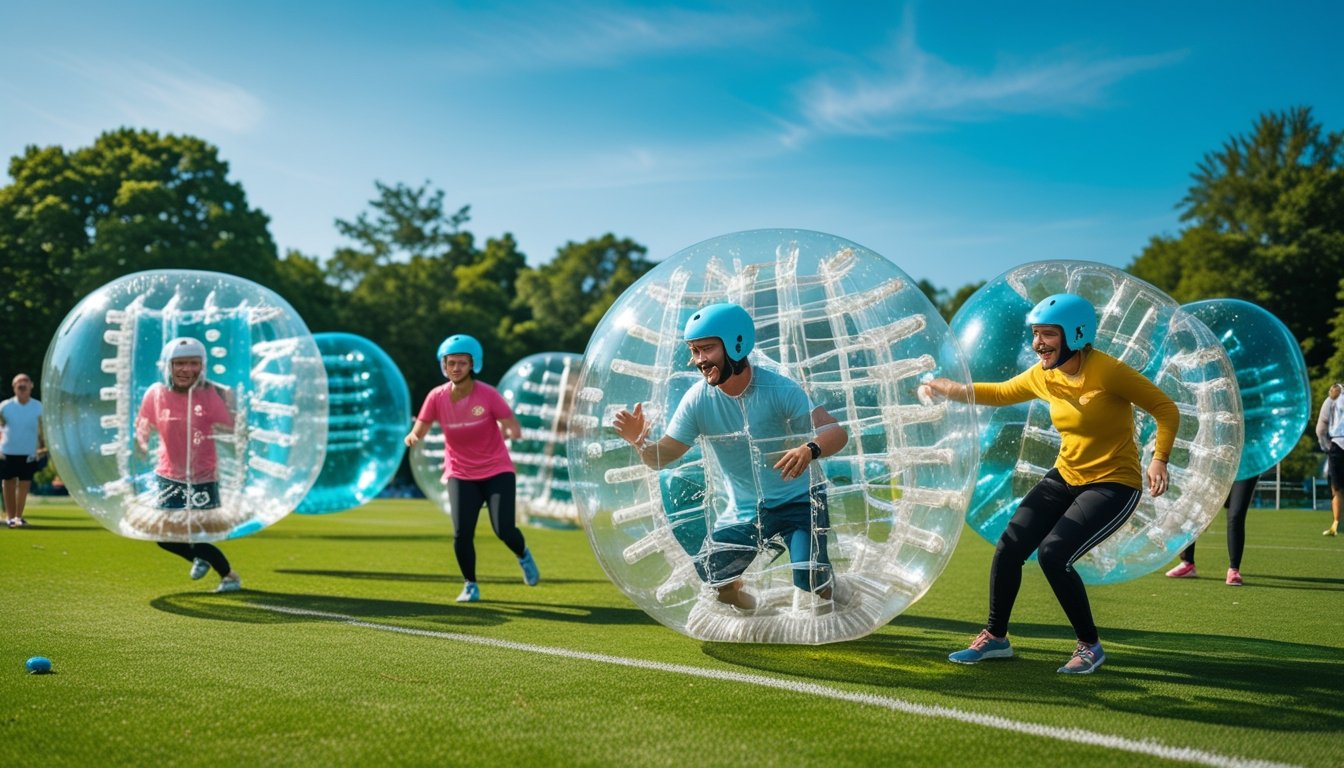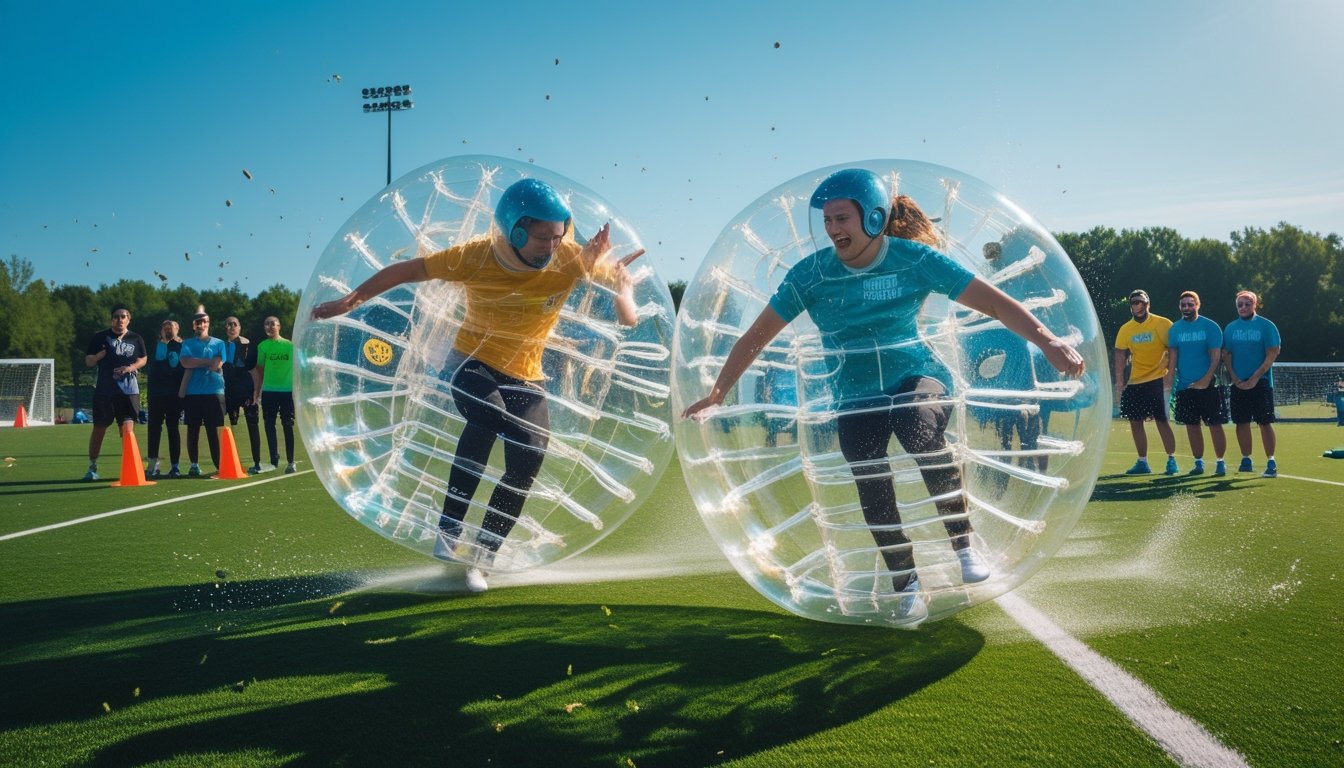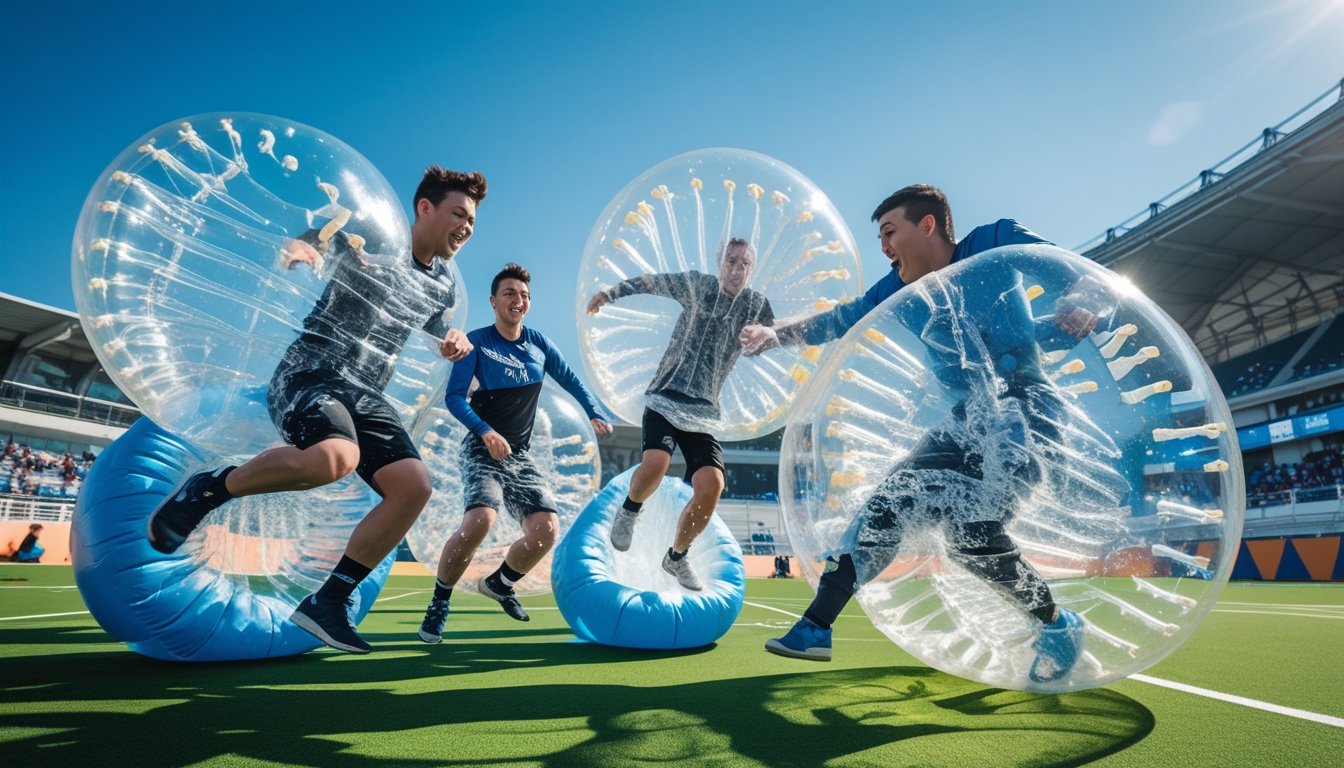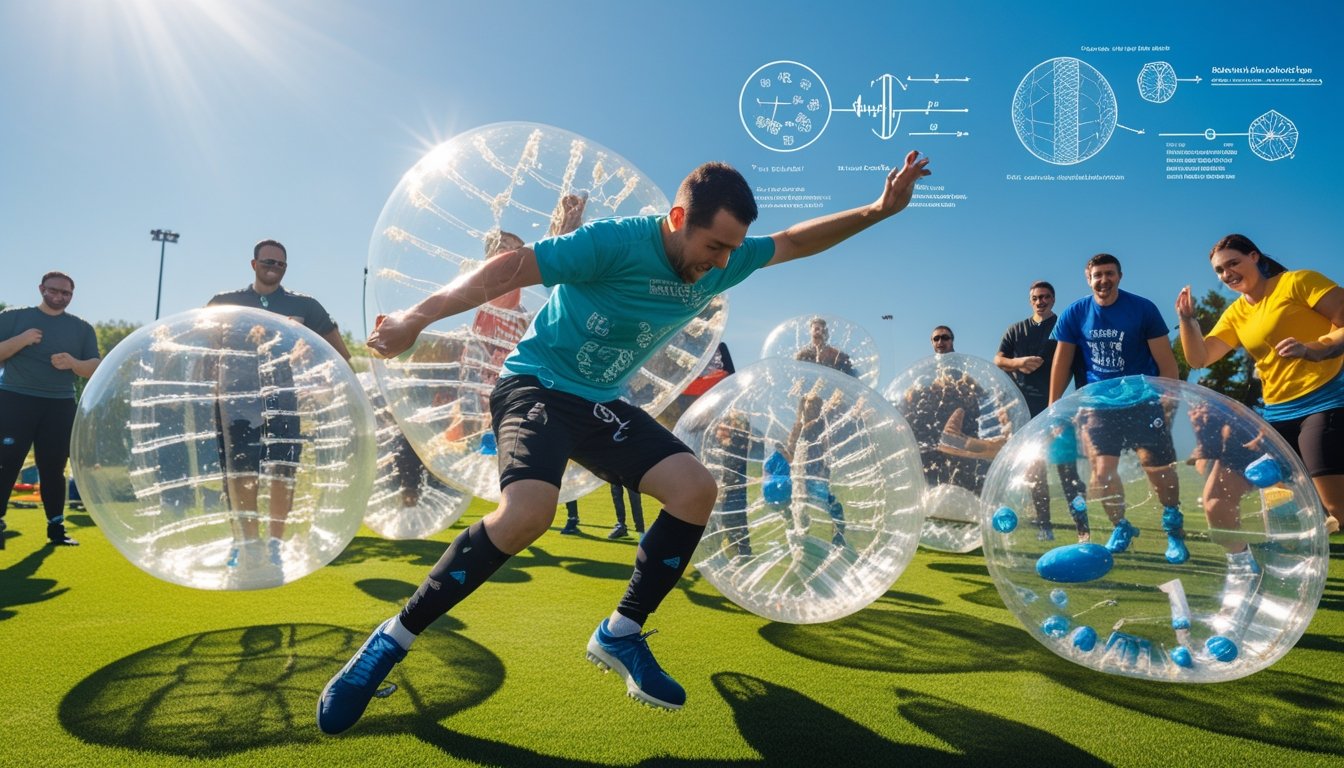Late updated: 19 Jun 2025 11:06
Written by: Emma Saunders
Exploring the Science Behind Bubble Sports Physics: A Clear Analysis
The world of bubble sports is as fascinating as it is fun. Bubble football, a popular example, offers an entertaining twist on the classic game, combining physical activity with scientific principles. The physics behind bubble sports centres on fundamental forces like gravity and air resistance that influence player movements within the protective bubbles. Understanding these intriguing scientific dynamics not only enhances gameplay but also enriches our appreciation of how science and sport intersect.

As we explore further, we'll uncover how the mechanics of bubble sports involve more than meets the eye. From the way players move to the curious behaviour of the bubbles themselves, every game unfolds a new chapter in the story of sport and physics. With each bounce and collision, we're reminded of the unseen forces at work.
Through these explorations, we invite readers to discover not just the science, but the sheer joy that comes from experiencing bubble sports. Whether you're a player or an enthusiastic observer, the knowledge of these underlying scientific principles will add a new layer of enjoyment and understanding to the action.
Key Takeaways
- Bubble sports rely heavily on physics principles like gravity and air resistance.
- Understanding these dynamics can enhance the gameplay experience.
- Scientific principles add depth to our appreciation of bubble sports.
Core Principles of Bubble Sports Physics

In exploring the science behind bubble sports, we will dive into the physics governing bubble movement, the influence of forces and gravity in gameplay, and the chemical composition of soap bubbles. These core principles provide the foundation for understanding how bubble sports operate.
Scientific Laws Governing Bubble Movement
Bubble sports rely heavily on the basic laws of physics, such as Newton's laws of motion. The inertia and momentum of bubbles provide dynamic movement, creating interesting gameplay scenarios. When players in bubble suits move, their speed and trajectory can be described by these principles. Differential equations also come into play, as they help model the bubble interactions in the environment.
Mathematics describes the relationship between velocity, acceleration, and the forces at work. As bubbles collide and bounce off each other, physics dictates the resulting paths. Precise calculations ensure players experience smooth, controlled motion. These scientific laws are crucial to the mechanics of bubble sports, and understanding them adds depth to our appreciation of these innovative games.
The Role of Forces and Gravity in Gameplay
Gravity is ever-present in bubble sports, as it governs the movement and balance of the players. Each player experiences a gravitational pull that affects the bubble’s trajectory as they run, jump, or collide. The force of gravity interacts with air resistance, altering how bubbles move through the air.
Additionally, the force exerted by players controls their ability to push against each other, creating intriguing strategies and physical engagements. Knowing how to effectively use force is essential to mastering bubble sports. Players can change direction, halt their opponents, or gain momentum. By understanding how gravity and forces interrelate, we can better appreciate the skill and technique that bubble sports require.
Material Science: Soap Bubble Composition
Soap bubble composition is central to bubble sports. The elasticity of soap film allows bubble suits to withstand collisions. Chemistry plays a vital role in determining the ideal soap and water mixture, which ensures durability and flexibility. Soap molecules have properties that allow for the stability and stretching needed in bubble sports equipment.
In bubble sports, the structural integrity of the bubble is key. A well-designed bubble effectively balances the air pressure inside with external forces. This balance comes from the careful chemistry of soap solutions, allowing the bubble to maintain shape even under stress. By comprehending the material science behind bubble sports, we can appreciate the delicate yet robust nature of these bubbles.
Applications in Competitive Environments

Bubble sports, particularly those involving soccer, bring a unique blend of entertainment and science to competitive arenas. They present valuable learning opportunities by mimicking principles found in complex scientific fields such as astrophysics. Performance analytics and predictive modelling further enhance the strategic aspects of these sports.
Bubble Physics in Soccer and Other Sports
In the fascinating world of bubble sports, physics plays a pivotal role, especially in soccer. When players don transparent, inflatable bubbles, the dynamics of the game change drastically. Air resistance and the players' reduced range of motion require them to develop new strategies.
The cushioning effect of the bubbles influences collisions and tackles, reducing injury risks and changing how we perceive force and momentum. Observers notice that despite the bulky exterior, agility and speed remain crucial. This unconventional setup makes players rethink traditional soccer strategies to favour inventive play styles. The controlled environment in which bubble sports are played is ideal for experimental approaches in other sports, encouraging athletes to adapt and apply scientific thinking actively.
Performance Analytics and Predictive Modelling
Performance analytics have a transformative impact on bubble sports, providing detailed insights into player efficiency. By examining player movements through data capture and analysis, we can interpret patterns that highlight strengths and weaknesses. Metrics such as speed, collision frequency, and recovery times are monitored.
Predictive modelling harnesses this data to enhance strategy. By simulating different scenarios, teams can optimise their line-ups and game plans. It is akin to dissecting the game at the molecular level, making informed decisions to gain a competitive edge. Our analytics approach is similar to methods utilised in scientific fields, where precision and pattern recognition are paramount. This continuous feedback loop enhances gameplay and informs training sessions, fostering development.
Astrophysical Analogies and Educational Insights
Astrophysics shares intriguing analogies with bubble sports. The interaction dynamics within a bubble resemble those of celestial bodies surrounded by hydrogen clouds and dust. This parallel presents educational opportunities, allowing players and audiences to explore larger cosmic principles through sport.
We leverage this to enhance science education, introducing complex concepts in an accessible format. Students engage with physics theories practically, through games that illustrate these abstract ideas. Bubble sports have a unique potential to broaden our understanding of both sports and science, creating a platform where educational insights are not just observed but experienced firsthand. By integrating these subjects, we foster a deeper appreciation of both the universe's mysteries and the sport's beauty.
Frequently Asked Questions

We explore various aspects of bubble science, examining their formation, fundamental physics, scientific study, fascinating properties, and educational insights for children. This knowledge illuminates both the complexity and simplicity inherent in these captivating phenomena.
How is bubble formation explained by chemistry?
Bubble formation is a captivating process involving gas trapped by a liquid film. The elasticity of the liquid, often water mixed with soap, allows it to stretch and form a thin layer that surrounds the gas, resulting in a bubble. Surface tension plays a critical role in maintaining the bubble's shape.
What are the fundamental principles of bubble physics?
Bubble physics revolves around principles like surface tension, pressure differences, and buoyancy. These factors determine a bubble's size, shape, and stability. Greater pressure inside than outside keeps the bubble intact. Additionally, surface tension minimises the surface area, promoting the spherical shape we commonly observe.
Can you describe the study of bubbles and its scientific term?
The scientific term for the study of bubbles is "bubblology". It encompasses examining their formation, stability, and interactions with their surroundings. Researchers in this field employ principles from chemistry, physics, and mathematics to understand how bubbles behave under different conditions.
What are some intriguing facts about bubbles?
Bubbles showcase brilliant colours due to light interference, similar to a rainbow. Their lifespan is fleeting; however, soap bubbles can persist longer in humid environments. Interestingly, bubbles can combine to form larger ones, and their behaviour is useful in scientific applications like medical imaging and material science.
How do the properties of soap contribute to bubble creation?
Soap reduces water's surface tension, allowing it to stretch around the air and form a bubble. The soap molecules orient themselves with their hydrophilic ends in the water and hydrophobic ends facing outward, stabilising the bubble wall and preventing it from bursting quickly.
What educational explanations exist for the science of bubbles aimed at children?
For children, the science of bubbles can be explained through simple experiments. Demonstrations of bubble formations and colour patterns introduce concepts like surface tension and light reflection. Engaging activities, such as crafting giant bubbles or testing different soap solutions, make learning these principles exciting and accessible.
